1967 Belgian Grand Prix race report: Gurney's Eagle takes flight
Dan Gurney takes a first win for his own Anglo-American Racers team in the light weight Eagle car, breaking Tony Brooks Grand Prix average record with a time of 143mph
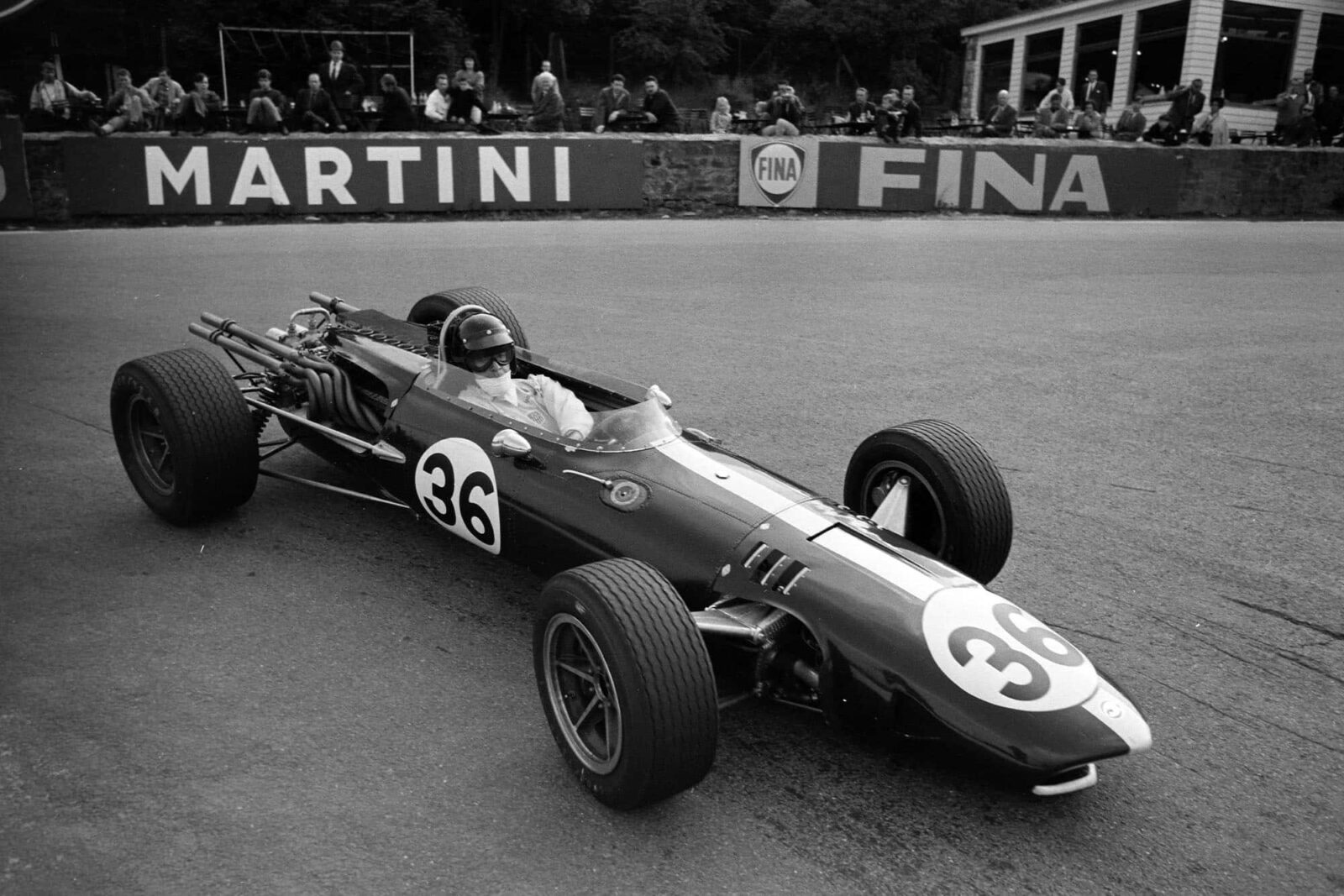
Dan Gurney took a first win for his Eagle T1G Weslake car.
Motorsport Images
Unlike the French, German and English national clubs, the Royal Automobile Club of Belgium have no doubts about the status and location of their Grand Prix. It takes place on the magnificent “National Circuit of Francorchamps” in the wooded hills above the town of Spa, and it represents Grand Prix racing at its best. The entry list was very similar to that at Zandvoort, as were the cars, Ferrari running the same three cars and drivers, Amon, Scarfiotti and Parkes, Honda had Surtees with their two 12-cylinder cars, BRM had Stewart with an H16 and a Tasman V8, and Spence, with a V8, Parnell with his Lotus-BRM V8 and an H16 BRM for Irwin, Team Lotus with the two Type 49 cars for Clark and Hill.
The Brabham team had the new car that practised in Holland, but now with a F1 Howland gearbox, for the owner, and the 1965 chassis with 1967 engine that Brabham raced in Holland, for Hulme. Cooper had the same three cars as Zandvoort for Rindt and Rodriguez, and Gurney had Eagle number 104, the lightweight titanium car and a spare car and engine. Anderson, Bonnier and Ligier had their own cars and Siffert the usual Rob Walker car. AAR-Eagle would have entered McLaren on one of their cars but were short of a good spare engine.
Qualifying
Practice from 4pm-6pm on Friday and Saturday afternoon saw Clark dominate everyone in the Lotus-Cosworth (Ford) V8 and while he was expected to go fast, few people were prepared for the speeds he achieved. Last year in practice Surtees was fastest at 3min 38.0sec, without too much effort with the 1966 Ferrari, so it was natural that 3min 40.0sec, this year should be minimum lap time for any works driver.
In May the Chaparral driven by Phil Hill had lapped at 3min 35.6sec (approx 146mph) so that the good 3-litre Grand Prix cars could expect to beat that, and it seemed within the bounds of possibility for a real flyer to approach 3min 30sec by the end of the second day. The Lotus cars had small air deflectors on the sides of the nose cowling as they were anticipating reaching 190mph and there was a feeling that the front might suffer from aerodynamic lift; Brabham was also trying similar deflectors. BRM arrived prepared to be depressed by the performance of the H16 cars and had lent one to Parnell, but before practice was very old they had snatched it back for Spence to drive, as they were agreeably surprised by the way the cars were going.
Stewart tried a V8 and an H16, as did Spence, and both soon settled for the 3-litre 16-cylinder cars which were getting well wound up on the fast descent to the Masta-ess-bend, even if they lacked some steam up the long drag from Stavelot to Francorchamps. Irwin felt his way round in Parnell’s Lotus-BRM. V8, then had a go in the H16 before it was snatched away, and finished up in the Tasman V8 that the Parnell team had used at Monaco.
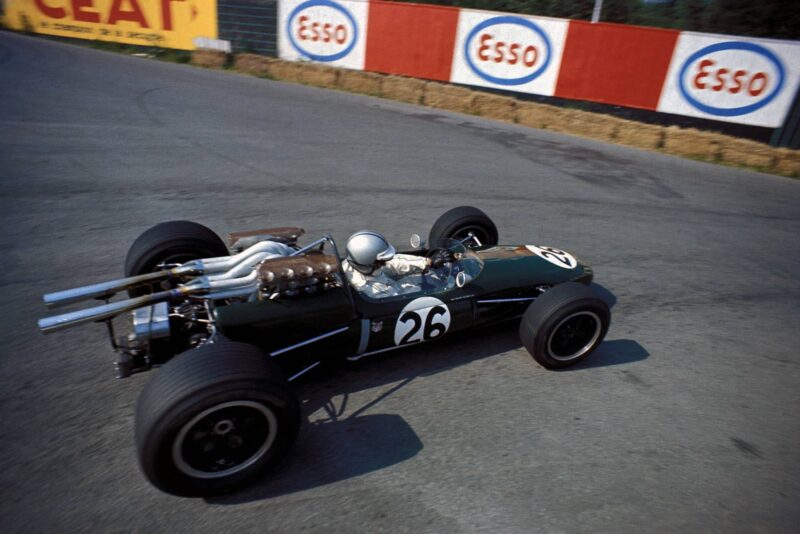
Neither Hulme (above) or Brabham were happy with their cars in qualifying
Motorsport Images
By 5pm, times were beginning to fall below 3min 40sec for a lot of drivers, but the Brabham team were not happy, for Hulme thought the handling on Brabham’s old car was awful and did not do any flying laps, so was untimed officially. Brabham had a go in it and seemed happy enough, but neither Repco engines were giving enough power to challenge the Cosworth engines.
“The Brabham team were not happy, for Hulme thought the handling on Brabham’s old car”
Towards the end of the second hour both Team Lotus drivers began to use their 400bhp, and everyone sat up when Clark did 3min 31.5sec and Hill 3min 32.9sec, while a watchful eye was kept on Gurney as he had done 3min 34.1sec on a lap where he slowed up and came into the pits at the end. Then Clark really showed who was the Grand Prix master-driver by clocking 3min 31.2sec, followed by 3min 29.0sec, an average speed of 242.870kph (approx 151mph) including the bottom gear hairpin at La Source – Grand Prix driving in its purest form.
Just before practice ended Gurney gave an impressive reply with 3min 31.2sec, the Eagle being in fine form. As Colin Chapman was not terribly satisfied with the Lotus chassis performance, one wondered what was to happen when he and Clark considered it to be right!
Next day was another of ideal weather conditions and for the first hour there was not too much activity or high speed motoring, Irwin was learning very nicely about Grand Prix driving with the V8 BRM, Amon was getting quite impressive with the leading Ferrari and Stewart was trying really hard with his H16 BRM and getting good results.
Poor Surtees could not even improve on his 1966 Ferrari time with the Honda V12 and was slower than the slowest Ferrari, driven by Scarfiotti. The Walker Cooper-Maserati had trouble in its gearbox so Siffert borrowed the spare works Cooper-Maserati for a number of laps, this one having the disc-type magnesium wheels.
Not long after 5pm things began to warm up and the pace quickened as everyone got wound up for a last do-or-die effort. Clark was about to do his “quick one” when he found Amon and Scarfiotti in his slip-stream, so he backed off and let them get well ahead and then put in a lap at a shattering 3min 28.1sec – 243.921kph (well over 151mph).
Gurney equalled his time of Friday, showing that it had been no fluke, but Brabham was only able to get a good time by reason of some crafty slip-streaming. Hill’s Lotus 49 was going quickly but blowing out oil from its Cosworth engine and he did not improve on his first day’s time, but Rindt and Stewart were both in fine form and really trying all they knew. It was becoming increasingly obvious that the really fast Grand Prix cars were beginning to out-perform their road-holding ability, a situation we have not known since 1951. Even the Lotus did not look its impeccable and serene self at the speeds Clark and Hill were cornering on the ultra-rapid Belgian circuit. The “cornering-on-rails” stuff we have become used to is disappearing now that real 400 horsepower 3-litre engines are on the go, and the drivers are earning their bread-and-butter.
Race
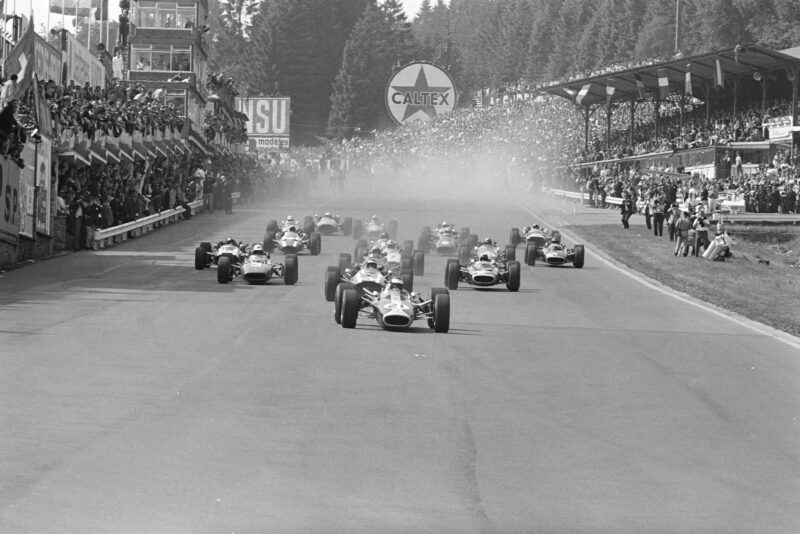
Clark leads at the start
Motorsport Images
The Belgian GP over 28 laps started at 3:30pm, but before that the drivers were taken round in a parade of cars driven by RACB club members, and then they did a reconnaissance lap in their racing cars before lining up on the grid. The front row was most impressive with Clark, Gurney and Hill in that order, Lotus 49, Eagle-Weslake and Lotus 49, with a total of more than 1200 horsepower between the three of them and all capable of using it all. Neither Lotus was using the air deflectors on the front.
A “dummy-grid” line-up was used for starting engines and Hill fumbled the starting of his Cosworth V8 and flattened the battery in the process so had to stay on the dummy grid while the other 17 cars rolled down to the starting line and were away, with Clark leading up the hill after the Eau Rouge, followed by Rindt, Stewart, Parkes, Amon, Surtees, Rodriguez and Gurney, the Eagle hesitating off the line.
“Parkes got into a slide and crashed badly, being thrown out onto the edge of the road as the Ferrari turned over”
The unhappy Hill free-wheeled into his pit where another battery was fitted and he joined the race when everyone else was down at Stavelot. On the fast and deceptive left hand bend at Blanchimont Parkes got into a slide and crashed badly, being thrown out onto the edge of the road as the Ferrari turned over. The leaders charged down past the pits with Clark already well in the lead, followed by Stewart in an H16 BRM going really well, then came Amon, rather depressed at having seen his team-mate crash, Rindt, and Gurney making up for his bad start.
On the way back from Stavelot on the opening lap the Honda broke its crankshaft and Surtees came free-wheeling into the pits, stopping briefly at the Ferrari pit to tell them about Parkes. A lonely Graham Hill went by and then Irwin free-wheeled down the hill to the pits with a broken camshaft in his V8 BRM engine. It had indeed been a momentous opening lap.
Clark set off with a second lap in 3min 35.9sec and just ran away from everyone, with Stewart struggling gamely to keep the Lotus in sight and Gurney in third place. Then came Amon, Brabham, Rodriguez and Rindt in a struggling and rather unruly bunch, with the young New Zealand Ferrari driver being surrounded by the other three. Some way back Spence was keeping his H16 BRM ahead of Scarfiotti’s Ferrari, but he, like Amon, was rather put off by the sight of Parkes’ crash. Hulme was having an unhappy time racing against Bonnier, and Siffert in Rob Walker’s car, Anderson and Ligier were bringing up the rear, apart from Hill who stopped at the pits on lap 2 and again on lap 3, to retire with an inoperative clutch and gearbox.
By five laps there was the perfect exhibition of the present situation in Grand Prix racing and high-speed driving in as highest form, for Clark (Lotus), Stewart (BRM) and Gurney (Eagle) were way out ahead of everyone else, the rest appearing to be struggling along like a lot of beginners. This situation was a fine picture of the overall scene, of the combination of driver, car, engine, and team, the two missing drivers being Hill and Surtees who were both in the pits.
In a very efficient manner Parkes had been brought to the ambulance station behind the pits and on lap 8 a Ferrari mechanic held out a signal to Amon and Scarfiotti which read “PARX OK,” for his injuries were restricted to a broken leg and a broken wrist. However, Amon was not ok for he was behind Rodriguez and the Cooper-Maserati was spraying oil all over the Ferrari, and he did not have the speed to get by.
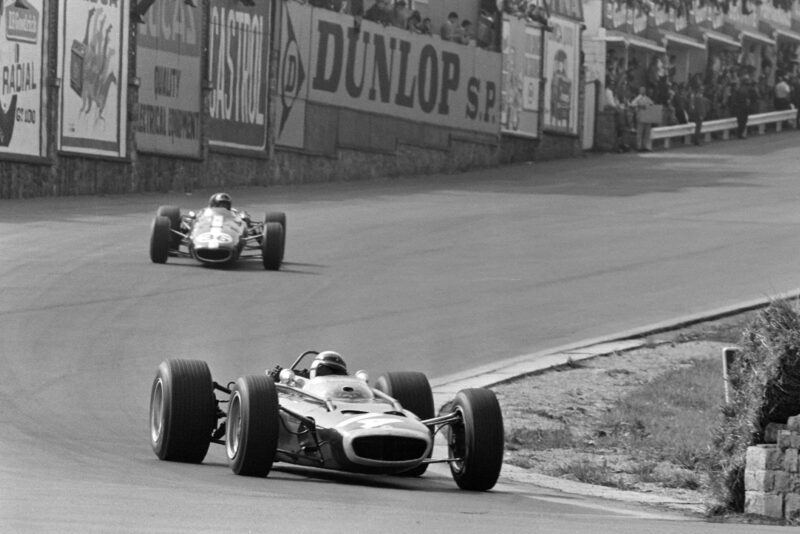
Stewart leads Gurney
Motorsport Images
Clark was motoring relentlessly on with a lap in 3min 33.3sec and by 10 laps he was 21 seconds ahead of Stewart, and at an average of over 145mph that was a long distance. Gurney was closing on Stewart but not rapidly enough to be a danger and the three of them looked and sounded superb, V8 followed by H16 and V12, a veritable mechanical delight. At the end of lap 12 Clark rounded the hairpin at La Source and then there was consternation as he headed for the pit, with the Cosworth engine running on seven cylinders.
“Clark was motoring relentlessly”
Stewart swept by into the lead, followed by the blue and silver Eagle-Weslake, but Gurney lilted off and dived into the pit area. He shouted that the fuel pressure was low and roared away. At the Lotus pit it was found that a sparking plug had disintegrated, probably having been over-tightened, but it was some time before Clark rejoined the race.
After this panic the order was Stewart (BRM), Gurney (Eagle), Brabham, Rodriguez, Amon, Rindt, and Clark was now seventh but a long way back, leading Scarfiotti, Spence and Hulme, while Bonnier had retired much to the relief of the number two Brabham driver; the remaining three, Siffert, Anderson and Ligier had all been lapped.
Gurney was 14 seconds behind Stewart at the end of 14 laps, but did not seem to be gaining rapidly, and in third place was Rodriguez, but a long way behind, and he was followed closely by Amon and Rindt, with Brabham well behind them, having been leading them on the previous lap. There was obviously trouble brewing in the Brabham-Repco V8, but it was not alone for Clark returned to the pits as another sparking plug had failed, this time due to a fault in its structure, and just afterwards Hulme stopped as the oil scavenging system on his Repco V8 engine was not functioning properly and the base chamber was filling with oil. This was also Brabham’s trouble and he had to give up on the next lap.
Clark got going again but now his clutch was not freeing properly and with baulk-ring synchromesh in the ZF gearbox gear changing was not easy. After struggling with the lever the operating mechanism became deranged and he was left with movement in only one direction, which gave him third and fifth gears, but he carried on with no hope of doing anything more spectacular than finishing.
Stewart was just about holding his own against Gurney’s onslaught, the BRM H16 cylinder engine going well and at 17 laps he was still 12 seconds ahead, but then he had trouble in the connection between the gear-lever in the cockpit and the selector mechanism in the gearbox at the back of the car. When he had the lever in the right place the mechanism at the back was out of step and in neutral the rpm kept going to over 12,000!
While Stewart was holding the lever with one hand and steering with the other. Gurney caught up 4 seconds a lap and on lap 21 they raced past the pits side-by-side, Gurney getting the lead up the hill to Burnenville. At that moment Scarfiotti was in the pits with a broken hydraulic pipe on his rear brakes and a repair was being effected, and meanwhile Amon had at last got ahead of the two Cooper-Maseratis and was pulling well away from them. Spence had not yet been lapped by the leaders, but Clark was a lap behind and cruising round to finish.
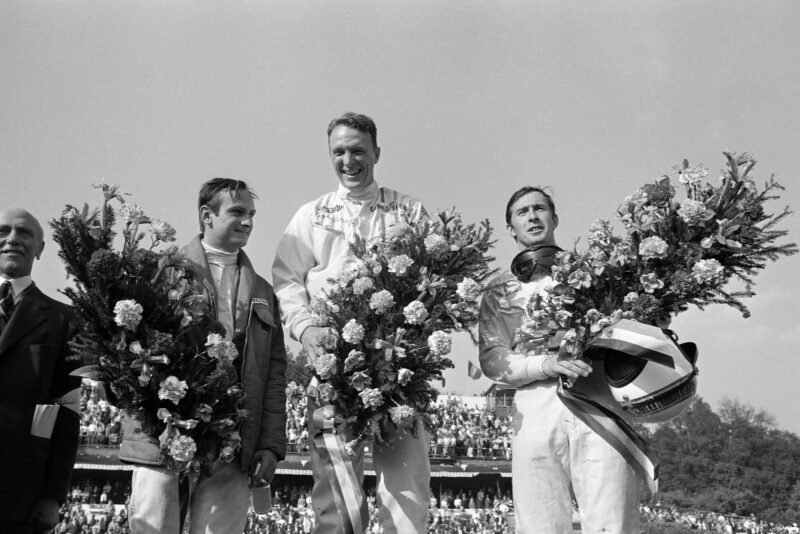
Gurney was ecstatic after a first Grand Prix win for his AAR team
Motorsport Images
As Stewart’s gear selection trouble got worse and worse, Gurney sailed on into a commanding lead, the Eagle-Weslake V12 looking and sounding superb, the only fault being that oil was spraying out of the catch tank onto the exhaust pipes and making ominous-looking blue smoke. This in itself was no worry, but the fact that there was that much oil in the catch-tank was disturbing. With only four laps to go the Maserati engine in Rodriguez’s Cooper blew up, which was no great surprise for the young Mexican had been having a pretty spirited motor race, so this left Rindt in fourth place.
“As Stewart’s gear selection trouble got worse and worse, Gurney sailed on into a commanding lead”
On the penultimate lap Amon was signalled to switch on his reserve fuel pump, secure in third place, but over a minute and a half behind the leader. Amid much rejoicing in the Eagle pit, and no doubt a lot of quiet satisfaction at Weslake Engineering back in Sussex, Dan Gurney won the Belgian GP at record speed and with a new lap record that he had set up during his chase of Stewart. The BRM team were well satisfied with the performance of the H16 cylinder cars, both of them finishing and Stewart felt he could have kept Gurney at bay had his gearbox not gone wrong. Team Lotus were slightly chastened by their misfortunes, but the practice laps and the opening part of the race convinced them that they had not got much to fear from any opposition.
Spa Spurts
- Progress. Just one year ago the first Gurney Eagle car appeared at Spa, with a 4-cylinder Coventry-Climax engine.
- The Lotus 49 must surely be the fastest Grand Prix car ever built, as regards power to weight ratio and circuit performance, and that includes the supercharged Mercedes-Benz of pre-war times.
- The Belgians were unwise enough to hold a Formula Vee race during their Grand Prix meeting. A driver was killed in practice and the winner and the second place man were disqualified for tuning their engines beyond the regulation limits. Why not stick to simple Grand Prix racing?
- Both Gurney and Stewart were on Goodyear tyres. Goodyear claim to “win the big ones.” Indianapolis, Le Mans, Belgian GP on successive week-ends seems to substantiate their claim.
- The sooner Surtees goes back to Ferrari the better for everyone.
